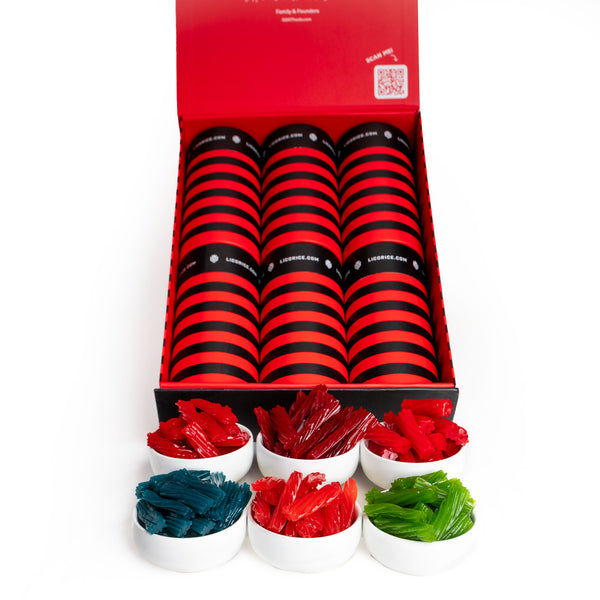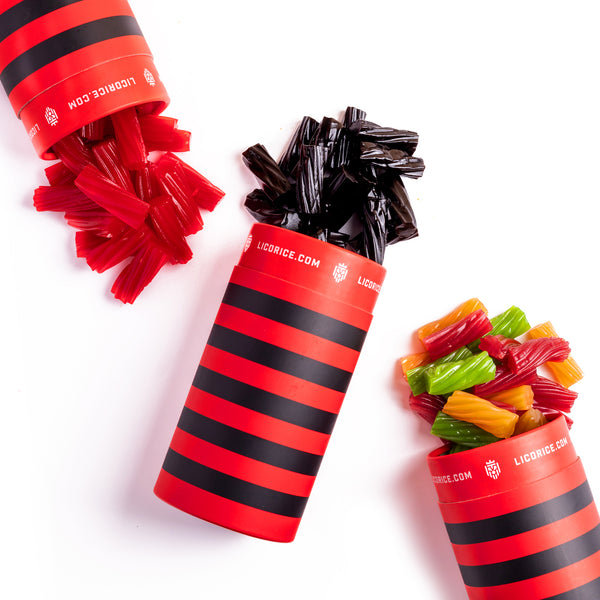Licorice lovers all over the world will tell you that what most people call licorice today technically isn't licorice at all. What these delicious licorice treats are made of also varies depending on which country you live in.
The flavor of what's known today as "black licorice" traditionally comes from the licorice plant, Glycyrrhiza glabra. The roots of the licorice plant are very sweet and sometimes are even sold by themselves as a treat at old-style confectionaries.
Black Licorice Flavor
Today, black licorice candy made in the United States does not typically contain any licorice root extract.

Licorice made in the U.S. is usually flavored with other compounds without the root extract, glycyrrhizin, also known as glycyrrhizic acid, the compound that makes licorice sweet and gives it that signature taste. Anise or aniseed oil is commonly used to replace glycyrrhizin in those sweets, though occasionally sometimes other flavorings are used.
Outside the United States, licorice makers usually use the licorice root extract itself, though sometimes the flavor is enhanced with anise oil because anise tends to be a less expensive ingredient than real licorice root.
Other natural flavors from berries or fruit are sometimes added to enhance or subtly alter the taste of one type of licorice from another. Natural flavors can be tweaked to the manufacturer's preference by adding artificial flavors or aromatics to the licorice as well.
Sweeteners
Some traditional licorice makers use molasses to compliment the natural sweetness of the licorice plant roots without any additional sweeteners. How black licorice is sweetened depends on the manufacturer and the type of sweets being produced.
However, since most licorice candy is sweet, additional sweeteners are often added.

Sugar is commonly used and is useful because it dissolves easily in the water that forms the initial basis for bringing the flavor and the rest of the licorice ingredients together.
Corn syrup is another common sweetener in licorice. It's typically used in addition to sugar because using multiple types of sweeteners enhances the sweetness properties of both on the tongue as you enjoy the treat. Corn syrup also inhibits sugar's crystallization during the cooking process and helps keep the licorice fresh.
Occasionally, other sweeteners in addition to those already mentioned may be added to the licorice mix including glucose syrups, honey, and/or maple sugar. Some sugar-free licorice incorporates artificial sweeteners like aspartame or sucralose. Most of these sweeteners, though, are found in one specialty product or another.
The Base

Most traditional licorice candy uses wheat flour as a base. Other starches or flours are sometimes used when creating gluten-free black licorice. Other ingredients like gum arabic and gelatin help bind all the ingredients together to keep the licorice stable on the shelf in the same shape and quality as it left the manufacturer.
The flour/starch forms the basis for the dough that ultimately becomes the tasty licorice we're all familiar with. The properties of the starchy base as it cooks also help give licorice the shine that we all associate with this delicious treat.
Additional Ingredients
Depending on the type of licorice, other ingredients may be used. For example, Dutch and Finnish licorice often contains ammonium chloride rather than sodium chloride, in salty licorice to give those confections the salty taste they're known for.

Even regular black licorice can contain some ammonium chloride, though, as a complement to the sweetness. This sounds counterintuitive, but a similar technique is regularly used in baking and making other types of candy like caramels.
Other ingredients that may be included are natural or artificial colorants. Traditional black licorice uses the licorice plant root not only for flavor but for color as well. Liquid caramel color can be used for a similar effect in candy that doesn't use licorice root for flavoring.
Smaller licorice producers may also use beeswax for a shiny surface. Other licorice manufacturers may use a very light coating of soybean oil to create a similar effect and enhance the licorice's natural shiny exterior.
Red Licorice
As you've likely already gathered, red licorice candy does not contain any amounts of licorice root at all. Instead, the main flavorings are usually strawberry, cherry, or raspberry (with varying amounts of natural and artificial flavoring). This is similar to Licorice.com's Strawberry Spirali Licorice, Raspberry Pretzelice, and the Finnish Red.

Additionally, citric acid can be added to give tanginess to fruit-flavored licorice candy. Natural and artificial colors are used to give red licorice (and other fruity licorice) their vibrant colors.
More recently, in the United States and Australia, similar types of licorice have been introduced in a wide variety of colors and flavors including apple, mango, and watermelon - just to name a few. Licorice.com provides similar delicious treats with the Australian Mix coming in the flavors of fruity mango, sweet strawberry, and mouth-watering green apple! Don't forget to check out our entire Australian licorice collection!
None of these have the traditional black licorice flavor. However, the rest of the ingredients and the manufacturing process are the same for fruit-flavored licorice as with traditional licorice.
Manufacturing Licorice

As mentioned above, all types of licorice are cooked slowly to make a dough, after which, the candy takes its final form. This can occur in one of two ways, depending on the manufacturer.
Smaller licorice makers may use a cornstarch molding process. With this method, the hot licorice is poured into individual molds.
Once cool, the molds are turned over and the sweets fall out, ready for packing. Both large and small manufacturers use extruders to produce the licorice ropes and twists we're all familiar with. In this case, the hot licorice is boiled to the point where it thickens into the dough before being forced through a machine that gives it the rope shape.
Licorice: The Sweetest Treat!
From the traditional licorice root taste of black licorice to the sweet-tart fruitiness of the newer green apple licorice, all types of licorice candy are manufactured in very similar ways. This results in the chewy texture you love - whether you consider yourself an aficionado or just a casual licorice fan looking for a great sweet treat. And that's something we all can agree on!

Licorice.com wants to help you get those lovable treats, so make sure to check out the array of options for you, a gift for a loved one, and even customize your licorice buying experience! Also check out our post on National Licorice Day!
















